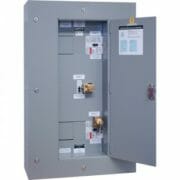
External Maintenance Bypass 101
Businesses use emergency back-up power systems to ensure availability of their most critical applications. What happens then, when the critical power system needs maintenance done, or if the UPS system has an issue itself? Like a vehicle, back-up power equipment needs regular maintenance or “tune-ups” to ensure it continues running correctly. However, there are times when back-up power equipment is so critical that it cannot be taken offline, even for maintenance. Having an External Maintenance Bypass is a way to allow critical power systems to have more flexibility while maintenance is done, keeping equipment online without interruption to loads.
We know an External Maintenance Bypass (EMB) is important, but we need to know more about what it is and how it works. The EMB is typically mechanical, in a NEMA rated enclosure with either a rotary switch or circuit breakers. The EMB can be in-line in a matching cabinet enclosure or could be wall-mounted external panel. In most installations, an External Maintenance Bypass:

- Allows the engineer to isolate power to completely bypass the UPS with no load interruption, or
- Allows the engineer to completely remove power from the system for servicing or removal, without any load interruption.
If there is no External Maintenance Bypass switch in place, often the only safe thing to do is to power down the entire system to ensure safe work or to swap the unit out.
Note that External UPS Maintenance Bypass and Internal Static Bypass are not the same, nor serve the same function. Internal Maintenance Bypass switches, or Static Bypass switches in online UPS systems, only allow for safe maintenance work in electrically isolated parts of a UPS system. In this instance, some of the UPS areas may still be live, including busbar connections. Often, Static Bypass switches are used to bypass normal UPS operation in cases of high inrush or fault conditions.
The key component of an EMB is its switching mechanism. There are two main configurations commonly seen in the field for an External UPS Maintenance Bypass switch:

Rotary Bypass – These have two different configurations: “Make-before-Break” or “Break-before-Make.” These switches are often used in smaller to mid-range UPS systems. “Make-before-Break,” parallels external and internal UPS circuits for short periods so the user does not break the circuit to the load. “Break-before-Make” disconnects the circuit for short periods to disrupt power to the user’s load transfer.
Breaker Bypass – This configuration has 2 common types:
- In-Line, Matching Enclosure: This type of UPS maintenance bypass is designed to sit adjacent to the UPS and is similarly sized to the UPS based on its enclosure design. While this can be a great option, it also can potentially limit UPS replacement choices in the future.
- External, Wall-Mounted Bypass Panel: These systems can contain 2, 3 or more breakers dependent on site configuration requirements. They can also include distribution breakers for branch circuits, eliminating the need for additional equipment.
Learn more about the technical detail of an External Maintenance Bypass now!
External Maintenance Bypass switches are a worthy investment for the amount of downtime they typically save. Contact QPS and our engineering team to talk about how to select and size the proper External Maintenance Bypass for your critical power system.
Published on Sep 06 2018
Last Updated on Oct 17 2023

